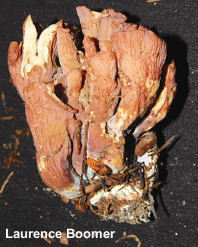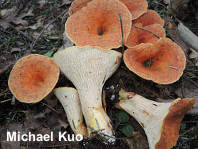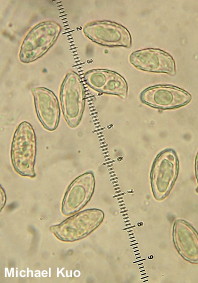| Major Groups > Chanterelles and Trumpets > Gomphoid Mushrooms |

|
Gomphoid Mushrooms [ Basidiomycota > Gomphales > Gomphaceae . . . ] by Michael Kuo Gomphoid mushrooms are generally sturdy, fleshy, and vase-shaped, with wrinkled outer surfaces. They are more common in northern and montane forests, and most species are mycorrhizal partners with trees. Preliminary research (Giachini, 2004) has indicated a potential relationship between the appearance of Gomphus fruiting bodies and the volume of woody debris present. The traditional distinction between gomphoid mushrooms and the chanterelles is that the former have large, coarse scales on the cap Identification of gomphoid mushrooms is not difficult, and can generally be accomplished without microscopic analysis. In fact, this is one area where DNA studies over the last decade or so have made things easier for would-be identifiers, rather than more difficult; a substantial number of species traditionally separated from Turbinellus floccosus (née Gomphus floccosus) on the basis of minor differences in colors and spore sizes have been reduced to synonymy with Turbinellus floccosus on the basis of molecular results. If you are wondering what happened to the Gomphus described in your field guides, research by Admir Giachini (2004, 2010, 2011) has made several important findings. First, DNA suggests that the genus Gomphus should be limited to three species centered around Gomphus clavatus (which is the only one of the three occurring in North America). Second, the species traditionally centered around "Gomphus floccosus" should be treated in a separate genus; Giachini proposes an older genus name, Turbinellus. Third, as noted above, many of the floccosus-like "species" are so genetically similar that they probably do not deserve separate species status. Fourth, the floccosus-like and clavatus-like groups are distant enough, genetically, that several species of Ramaria (see Clubs and Corals) are grouped between them, indicating a clear separation. Last (for our purposes here, anyway), some species traditionally treated in Gomphus are even more distantly related, and belong in the little-known genus Gloeocantharellus. |
|
|
Key to 3 Gomphoid Mushrooms in North America
References Bigelow, H. E. (1978). Cantharelloid fungi of New England and adjacent areas. Mycologia 70: 707–756. Corner, E. J. H. (1966). A monograph of cantharelloid fungi. Oxford: Oxford UP. 255 pp. Giachini, A. J. (2004). Systematics, phylogeny, and ecology of Gomphus sensu lato. Doctoral dissertation, Oregon State University. 446 pp. Retrieved 31 July, 2016 from: https://ir.library.oregonstate.edu/xmlui/handle/1957/10681 Giachini, A. J., K. Hosaka, E. Nouhra, J. Spatafora & J. M. Trappe (2010). Phylogenetic relationships of the Gomphales based on nuc-25s-rDNA, mit-12s-rDNA, and mit-atp6-DNA combined sequences. Fungal Biology 114: 224–234. Giachini, A. J. & M. A. Castellano (2011). A new taxonomic classification for species in Gomphus sensu lato. Mycotaxon 115: 183–201. Petersen, R. H. (1968). Notes on cantharelloid fungi. I. Gomphus S. F. Gray, and some clues to the origin of ramarioid fungi. Journal of the Elisha Mitchell Scientific Society 84: 373–381. Petersen, R. H. (1971). The genera Gomphus and Gloeocantharellus in North America. Nova Hedwigia 21: 1–118. Pilz, D., L. Norvell, E. Dannell & R. Molina. (2003). Ecology and management of commercially harvested chanterelle mushrooms. Portland, Oregon: USDA General Technical Report. 83 pp. Retrieved 31 July, 2016 from: http://www.fs.fed.us/pnw/pubs/gtr576.pdf Pine, E. M. et al. (1999). Phylogenetic relationships of cantharelloid and clavarioid Homobasidiomycetes based on mitochondrial and nuclear rDNA sequences. Mycologia 91: 944–963. Smith, A. H. (1968). The Cantharellaceae of Michigan. Michigan Botanist 7: 143–183. Thiers, H. D. (1985). The Agaricales of California. 2. Cantharellaceae. Eureka, CA: Mad River Press. 34 pp. This website contains no information about the edibility or toxicity of mushrooms. Cite This Page As: Kuo, M. (2021, August). Gomphoid mushrooms. Retrieved from the MushroomExpert.Com Web site: http://www.mushroomexpert.com/gomphoid.html © MushroomExpert.Com |


